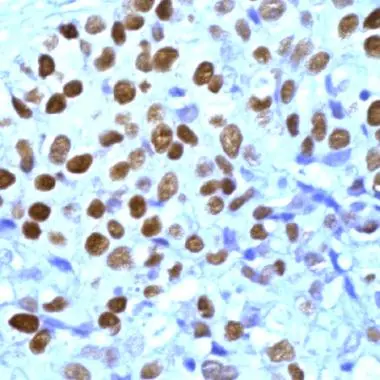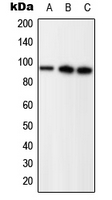
Human Breast Carcinoma stained with anti-Progesterone Receptor (PR) antibody (GTX15509)
Progesterone Receptor antibody (ready-to-use)
GTX15510
ApplicationsImmunoHistoChemistry, ImmunoHistoChemistry Paraffin
Product group Antibodies
TargetPGR
Overview
- SupplierGeneTex
- Product NameProgesterone Receptor antibody (ready-to-use)
- Delivery Days Customer9
- Application Supplier NoteIHC-P: Working dilution, ready to use for 10 minutes at RT. Staining of formalin-fixed tissues requires boiling tissue sections in 10mM citrate buffer, pH 6.0 for 10 minutes followed by cooling at RT for 20 minutes. Optimal dilutions/concentrations should be determined by the end user.
- ApplicationsImmunoHistoChemistry, ImmunoHistoChemistry Paraffin
- CertificationResearch Use Only
- ClonalityPolyclonal
- ConjugateUnconjugated
- Gene ID5241
- Target namePGR
- Target descriptionprogesterone receptor
- Target synonymsNR3C3, PR, progesterone receptor, nuclear receptor subfamily 3 group C member 3
- HostRabbit
- IsotypeIgG
- Protein IDP06401
- Protein NameProgesterone receptor
- Scientific DescriptionThis gene encodes a member of the steroid receptor superfamily. The encoded protein mediates the physiological effects of progesterone, which plays a central role in reproductive events associated with the establishment and maintenance of pregnancy. This gene uses two distinct promotors and translation start sites in the first exon to produce several transcript variants, both protein coding and non-protein coding. Two of the isoforms (A and B) are identical except for an additional 165 amino acids found in the N-terminus of isoform B and mediate their own response genes and physiologic effects with little overlap. [provided by RefSeq, Sep 2015]
- Storage Instruction2°C to 8°C
- UNSPSC12352203


![IHC-P analysis of human tonsil tissue using GTX30164 Progesterone Receptor (phospho Ser190) antibody [1154]. Left : Primary antibody Right : Negative control without primary antibody Antigen retrieval : heat induced antigen retrieval was performed using 10mM sodium citrate (pH6.0) buffer, microwaved for 8-15 minutes Dilution : 1:20](https://www.genetex.com/upload/website/prouct_img/normal/GTX30164/GTX30164_1329_IHC-P_w_23060722_507.webp)
![Western blot of whole cell T47D lysate prepared from cells that had been incubated in the presence of the synthetic progestin agonist R5020 (500 nM) showing specific immunolabeling of the ~90k PR-A isoform and the ~120 PR-B isoform of the progesterone receptor phosphorylated at Ser294 using Progesterone Receptor (phospho Ser294) antibody [608] (GTX30165). The immunolabeling is blocked by the phosphopeptide used as the antigen (not shown).](https://www.genetex.com/upload/website/prouct_img/normal/GTX30165/Progesterone-Receptor-phospho-Ser294-antibody-608__GTX30165-1_w_23060722_991.webp)

![IHC-P analysis of human fibroadenoma (serial sections) tissue using GTX01924 Progesterone Receptor antibody [16 + SAN27]. Note a smaller proportion of weakly staining tumor cell nuclei in A compared to B.](https://www.genetex.com/upload/website/prouct_img/normal/GTX01924/GTX01924_20200811_IHC-P_74_w_23053121_180.webp)
![IHC-P analysis of breast carcinoma tissue using GTX01926 Progesterone Receptor antibody [16]. Note the nuclear staining in a proportion of tumor cells.](https://www.genetex.com/upload/website/prouct_img/normal/GTX01926/GTX01926_20200811_IHC-P_75_w_23053121_418.webp)
![WB analysis of truncated MBP-PGR recombinant protein (1) andtruncated Trx-PGR(aa730-871) recombinant protein (2) using GTX83165 Progesterone Receptor antibody [8A11H1].](https://www.genetex.com/upload/website/prouct_img/normal/GTX83165/GTX83165_20170912_WB_w_23061322_973.webp)